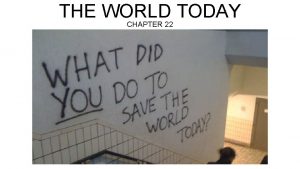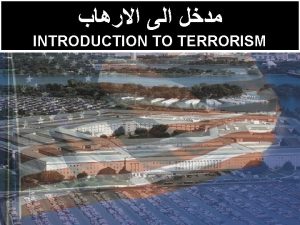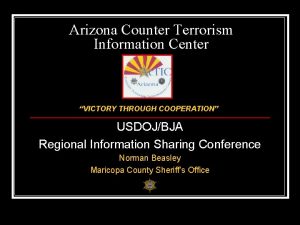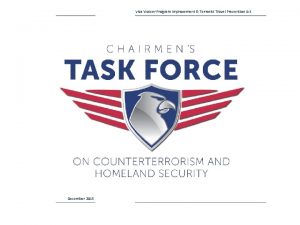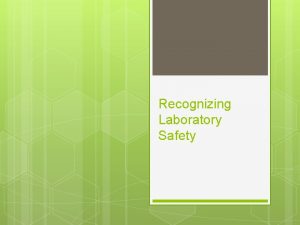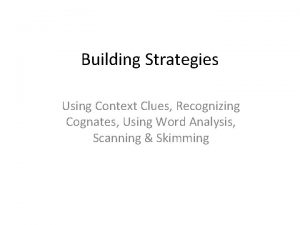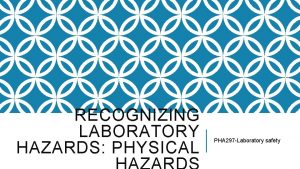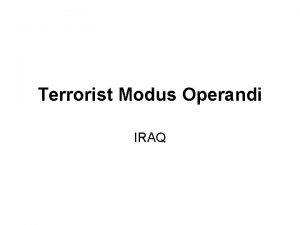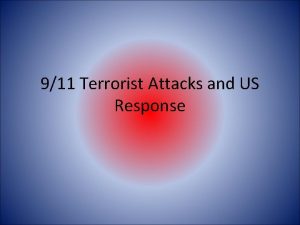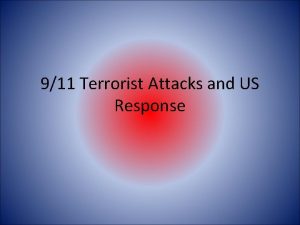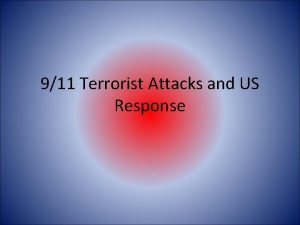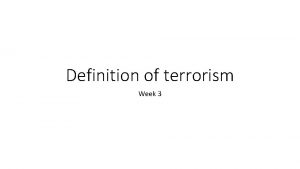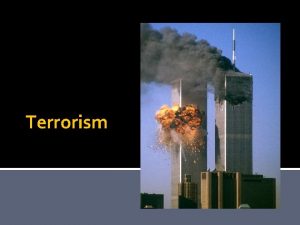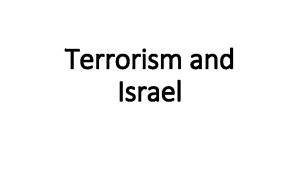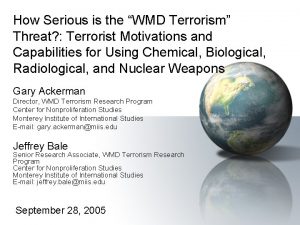Unit Six Recognizing Terrorist Activities 1 Terrorism Clues
































- Slides: 32

Unit Six Recognizing Terrorist Activities 1

Terrorism Clues • Occupancy • Type of event • Timing of the incident • On-scene warning signs 2

Occupancy • • • Government Buildings Schools Religious Buildings Public Assembly Points Mass Transit Systems Places with High Economic Impact 3

Occupancy (cont. ) • • • Military Installations Financial Institutions Entertainment Facilities Hospitals Utilities Places of Historical or Symbolic Significance 4

Type of Event ØPolitical Rallies Timing of the Incident ØHolidays, Birthdays ØCelebrations ØRecent Known Threats 5

On scene warning signs • • Suspicious persons leaving the area Suspicious vehicles in the area Signs and symptoms of WMD agents Secondary devices discovered 6

Target Analysis 1. 2. 3. 4. Ethnic, separatist Extreme Issue Foreign Terrorist Right or Left wing extremeist 7

Sources for WMD agents • • • Home production Laboratory production Industrial facilities Military Medical/university research facilities 8

Indicators of WMD Attack • Primary Indicators ØSymptoms of victims ØMass casualties ØCasualty pattern ØDissemination device ØWarning given or credit taken 9

Indicators of WMD Attack (cont. ) • Secondary Indicators ØDead animals or birds ØStatements of the victims ØThings out of place 10

Recognition of WMD / Hazmat Incident • • • Chemical Biological Nuclear Radiological Explosive ØIncendiary 11

Chemical • Recognition Ø The six clues Ø Victim signs and symptoms • Threats & Risks Ø Usually a liquid when containerized Ø May boil at low temperatures and become gases Ø Normally disseminated as gasses or aerosols Ø Most are influenced by weather conditions 12

Chemical (cont. ) • Basic Protection Measures ØSCBA only ØPPE ØDecontamination 13

Biological • Recognition ØLarge influx of calls ØSimilar signs and symptoms 14

Biological (cont. ) • Threats & Risks Ø Do not penetrate unbroken skin Ø Non-volatile Ø Are more toxic than chemicals by weight Ø Are undetectable by human senses Ø Have limited field detection Ø Disseminated as aerosols Ø Effects range from skin disorder to death Ø All are obtained from nature Ø Are relatively easy to produce Ø Have a delayed effect 15

Biological (cont. ) • Basic Protection ØSCBA ØAPR with HEPA filter ØProtective clothing ØGood sanitation ØDecontamination 16

Radiological/Nuclear • Recognition ØDirty Bombs ØSmall explosions that create dusts • Threats & Risks ØAlpha particles ØBeta particles ØGamma Radiation 17

Nuclear (cont. ) • Risks Ø The total amount of radiation received Ø The dose rate Ø The specific type of radiation • Health risks Ø Exposure Ø Ingestion Ø External contamination Ø Internal contamination 18

Nuclear (cont. ) • Basic Protection ØTime ØDistance ØShielding • • SCBA APR PPE Decon 19

Explosive • Recognition ØVehicles ØPipe bombs ØSatchel devices ØIEDs 20

Explosives(cont. ) • Threats & Risks ØBlast Pressure (Positive & Negative) ØFragmentation ØThermal 21

Explosive (cont. ) • Basic Protection Measures • Watch out for: Ø Abandoned containers Ø Incidents preceded by a written or verbal threat Ø Trip wires / booby traps Ø Suspicious mailings Ø Strong chemical odors Ø Devices containing unknown items Ø Multiple explosions 22

Incendiary • Recognition Ø Road flares Ø Gasoline and motor oil Ø Light bulbs Ø Common electrical components Ø Matches Ø Household chemicals Ø Fireworks Ø Propane and butane cylinders Ø Plastic pipes, bottles and cans 23

Incendiary (cont. ) • Threats & Risks ØBasic types of incendiary devices • Chemical • Electronic • Mechanical ØDelivery of incendiary devices • Hand thrown • Stationary • Propelled 24

Incendiary (cont. ) • Basic Protection Measures ØPPE ØObservation of: • • • Secondary timed devices Multiple fire locations Signs of accelerants Flammable liquid containers Splatter patterns Fusing residue 25

RESPONDERS SHOULD ALWAYS BE OBSERVANT OF SECONDARY DEVICES!! 26

Potential Outcomes for Terrorist CBRNE Event • • • Thousands of casualties Residual contamination Overwhelmed emergency services Disrupted municipal functions Panic and confusion Loss of faith in the responders 27

Role of the First Responder Awareness at WMD / Hazmat Incident • Recognition and identification • Protect themselves and others • Notify authorities 28

Basic Isolation Procedures for WMD / Hazmat • Isolate the area for protection and pending arrival of proper authorities. 29

Protection of WMD Crime Scene • Remain extremely vigilant • You may be called upon to testify • Try to retain the evidentiary value of everything 30

Additional Contacts during WMD Incident • Who are you going to call? ØFBI ØState Responders 31

UNIT SIX QUIZ 32
 Terrorism definition
Terrorism definition France magazine
France magazine Terrorist
Terrorist Nato definition terrorism
Nato definition terrorism Arizona counter terrorism information center
Arizona counter terrorism information center Liberals vs conservatives apush
Liberals vs conservatives apush Boda boda clues and types of clues
Boda boda clues and types of clues The terrorist he watches
The terrorist he watches Wie wird man terrorist
Wie wird man terrorist Terrorist travel prevention act
Terrorist travel prevention act Terrorist
Terrorist Six types of context clues
Six types of context clues What are context clues?
What are context clues? The statement of cash flows helps users
The statement of cash flows helps users In these activities
In these activities Support activities and primary activities
Support activities and primary activities Primary activities definition
Primary activities definition A polygon with six congruent sides and six congruent angles
A polygon with six congruent sides and six congruent angles What is useful materials and harmful materials
What is useful materials and harmful materials Drawing inferences listening strategy
Drawing inferences listening strategy Recognizing opportunity
Recognizing opportunity Observing trends in entrepreneurship
Observing trends in entrepreneurship Argumentative text anchor chart
Argumentative text anchor chart Channel design decisions with examples
Channel design decisions with examples Recognizing opportunities and generating ideas
Recognizing opportunities and generating ideas Recognizing lab safety worksheet
Recognizing lab safety worksheet Entrepreneurial trends
Entrepreneurial trends Recognizing opportunities and generating ideas
Recognizing opportunities and generating ideas Strategy: recognizing cognates
Strategy: recognizing cognates Is argumentative a genre
Is argumentative a genre Chapter 3 recognizing opportunity
Chapter 3 recognizing opportunity Recognizing laboratory safety
Recognizing laboratory safety Identifying and correcting faulty sentences
Identifying and correcting faulty sentences
